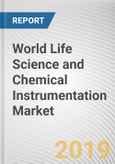Favorable government policies for pharmaceutical R&D in emerging nations and growing food safety concerns fuels the growth of the world life science and chemical instrumentation market. In addition, technological advancements in analytical devices supplements growth. However, high cost of instruments and presence of alternative technologies are factors restraining the growth of the market. On the other hand, growing proteomics market, increasing environmental safety concerns, and demand from applied markets are creating opportunities in the market.
The world life science and chemical instrumentation market is segmented based on technology, end users, and geography. The technology segment is further classified into chromatography, DNA sequencers & amplifiers, electrophoresis, lab automation, spectroscopy, microarray, flow cytometry, immunoassay, and other instruments. Other instruments include incubators, fume hoods, lab balances, and centrifuges. End users covered in the report are pharmaceutical, biopharmaceutical, & biotechnology companies, clinical research organizations, academic institutions, hospitals, clinics, & diagnostic laboratories, forensic science laboratories, food & agriculture industry, and environmental testing industry. The market is divided geographically into North America, Europe, Asia-Pacific, and Latin America, Middle East and Africa (LAMEA).
The prominent companies operating in the market are Agilent Technologies Inc., Bio-Rad Laboratories Inc., Becton, Dickinson, & Company, Bruker Corporation, Thermo Fisher Scientific Inc., F. Hoffmann-La Roche Ltd., Illumina Inc., PerkinElmer Inc., Danaher Corporation, Shimadzu Corporation, and Waters Corporation. Some of the key strategies adopted by these prominent manufacturers to strengthen their position in the market are partnerships, mergers & acquisitions, expansions, joint ventures, collaborations, and others.
KEY BENEFITS FOR STAKEHOLDERS:
The report offers an extensive analysis of key driving and restraining factors of the world life science and chemical instrumentation market.
This report offers an in-depth quantitative analysis of the current market and estimations through 2015-2020, which assists in identifying the prevailing market opportunities.
The report provides an extensive analysis of current and future market status of the world life science and chemical instrumentation market.
An in-depth analysis of key strategies adopted by leading manufacturers helps in understanding competitive scenario.
A comprehensive analysis of current research and clinical developments within the world life science and chemical instrumentation market is provided with key market dynamic factors that helps in understanding the behaviour of the market.
Competitive intelligence (of leading manufacturers and distributors of plasma fractionation) helps in understanding the competitive scenario across geographies.
Geographically, the world life science and chemical instrumentation market is segmented into North America, Asia-Pacific, Europe, and Latin America, Middle East and Africa (LAMEA).
KEY MARKET SEGMENTS:
By Technology
Chromatography
DNA Sequencers & Amplifiers
Electrophoresis
Lab Automation
Spectroscopy
Microarray
Flow Cytometry
Immunoassay
Other Instruments
Incubators
Fume Hoods
Lab Balances
Centrifuges
By End User
Pharmaceutical, Biopharmaceutic
Methodology
The analyst offers exhaustive research and analysis based on a wide variety of factual inputs, which largely include interviews with industry participants, reliable statistics, and regional intelligence. The in-house industry experts play an instrumental role in designing analytic tools and models, tailored to the requirements of a particular industry segment. The primary research efforts include reaching out participants through mail, tele-conversations, referrals, professional networks, and face-to-face interactions.
They are also in professional corporate relations with various companies that allow them greater flexibility for reaching out to industry participants and commentators for interviews and discussions.
They also refer to a broad array of industry sources for their secondary research, which typically include; however, not limited to:
- Company SEC filings, annual reports, company websites, broker & financial reports, and investor presentations for competitive scenario and shape of the industry
- Scientific and technical writings for product information and related preemptions
- Regional government and statistical databases for macro analysis
- Authentic news articles and other related releases for market evaluation
- Internal and external proprietary databases, key market indicators, and relevant press releases for market estimates and forecast
Furthermore, the accuracy of the data will be analyzed and validated by conducting additional primaries with various industry experts and KOLs. They also provide robust post-sales support to clients.

LOADING...








